The Torah: Genesis: "In the Beginning…" From Creation to Abraham
“In the beginning God created the heavens and the earth” (Genesis 1:1). These famous opening words of the Bible express the Hebrew and later the Christian belief about the foundation of the universe. Does the universe have meaning? Genesis tells us that it does. The universe was divinely conceived. Therefore, it can only be fully understood in light of a divine plan.
Here are some of the main things we learn from the creation account:
- God is the Creator (verse 1).
- God made everything there is, and it was very good (verse 31).
- The climax of God’s creation was the making of man and woman (verses 26-27). Human beings are different from other creatures in two essential ways. First, we are made in God’s image. Second, we have dominion over the rest of the physical creation.
- God’s six days of creative activity and the seventh day of rest set a pattern, which was later used for a weekly cycle of work and worship (Genesis 2:2-3; Exodus 20:11).
The poetic flow of the Hebrew language of Genesis is simple, yet profound. Creation is described as taking place in six days. Notice in the following box a summary of the creation week.
The purpose of the Genesis account is to establish God as Creator (Hebrews 1:10). It was never intended to be a scientific explanation of how he accomplished the creation. The Bible is not a science textbook. The scientist searches for the what and how of life’s questions, but the Bible addresses the who and why behind those questions.
Before scientific knowledge proliferated during the last 200 years, most Christians believed that Genesis 1 was a literal description of the beginning of the universe. Many Christians still do. However, a considerable number of Bible scholars today, while believing in the inspiration and accuracy of the Genesis account, find the traditional, literal interpretation inconsistent with evidence from scientific research.
These scholars have offered various explanations to account for these apparent inconsistencies. Some, having noticed that “light and darkness” is the subject of both the first and fourth days of creation (verses 3-5 and 14-19), “waters and sky” the subject of the second and fifth days (verses 6-8 and 20-23), and “land life” the subject of the third and sixth days (verses 9-13 and 24-31), believe the account to be a poetic or schematic portrayal of creation. For more on that, see “Are the Six Days of Creation Literal or Figurative?”
The Creation Week |
|
| Day 1: separation of light and darkness, day and night | Day 4: creation of sun and moon to govern the day and night |
| Day 2: separation of water and sky, the expanse | Day 5: creation of animals for the water and the sky |
| Day 3: separation of land and water; creation of plants | Day 6: creation of animals for the land, and humans to govern all animals |
|
Day 7: creation completed; God rests |
|
.gif) |
| “Now the Lord God had planted a garden in the east, in Eden; and there he put the man he had formed’ (Genesis 2:8). |
Other scholars consider Genesis 1:2-31 as describing a re-creation. This view was popularized by C.I. Scofield in his reference Bible, published in the United States in 1909. Scofield believed that Genesis 1:1 describes an initial creation that took place in the dateless past,” while verses 2-31 describe a re-creation of an earth being prepared for human life (The First Scofield Reference Bible, commentary on Genesis 1:2).
 |
| So the Lord God caused the man to fall into a deep sleep; and while he was sleeping, he took one of the man’s ribs…. Then the Lord God made a woman from the rib…. The man and his wife were both naked, and they felt no shame” (Genesis 2:21-22, 25). |
This theory attempted to harmonize the Bible and geology. The intervening gap between the beginning (verse 1) and the seven days of re-creation, Scofield reasoned, would be great enough to explain the fossils and rock strata found in the geological record. It would also explain the apparent contradiction between Isaiah 45:18 (New King James Version), which says that God did not create the earth “in vain” (Hebrew tohu), and Genesis 1:2 (NKJV), which describes the earth as being “without form, and void” (Hebrew tohu and bohu).
According to Scofield, the verb “was” (Hebrew hayah) should be translated “became.” Genesis 1:2, in this view, reads, “And the earth became without form, and void.” Although the Hebrew word allows for such a translation (it has the meaning of “became” in Genesis 19:26, Deuteronomy 27:9 and 2 Samuel 7:24), hayah is most often translated “was” throughout the Old Testament. Hence, it could also be translated, “Now the earth was without form, and void” (Jewish Publication Society translation, 1917).
While Bible scholars have proposed various interpretations of the creation account, Genesis does not explain the natural laws or the mechanism by which God created the universe. Genesis is not physics, astronomy or geology. It is a story of faith, telling why we came to be and to whom we belong. Its message is that “the earth is the Lord’s, and everything in it, the world, and all who live in it” (Psalm 24:1). It declares that in the beginning there was God, and that all things came to be as God called them forth.
This does not mean, however, that a Christian should leave scientific knowledge at the church door. When properly interpreted, scientific evidence may help us understand certain details. When scientific evidence seems to contradict biblical revelation, one or the other, or perhaps both, have been misunderstood. To read more about that, see “Must We Choose Between Science and the Bible?” at https://new.gci.org/science/choose.
“Image” and “likeness” of God: Genesis 1:26-27
The Bible makes an important distinction between humans and other living creatures. The animals were made after their kind (verse 25), but the man and woman were made in the image, or likeness, of God. This means that humans have a special relationship with God and can communicate with him.
Knowing that we are made in God’s image … provides a solid basis for self-worth. Human worth is not based on possessions, achievements, physical attractiveness, or public acclaim. Instead it is based on being made in God’s image. [Furthermore,] God made both man and woman in his image. Neither man nor woman is made more in the image of God than the other. (Life Application Bible, NIV, commentary on Genesis 1:26-27)
Men and women have equal access to God and can equally experience a personal relationship with him.
Adam and Eve disobey God Genesis 2:4–3:24
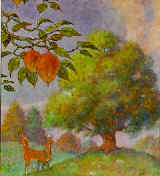 |
| “And the Lord God made all kinds of trees grow out of the ground – trees that were pleasing to the eye and good for food. In the middle of the garden were the tree of life and the tree of the knowledge of good and evil” (Genesis 2:9). |
This second account of creation is written from a different point of view: It focuses on the first humans. It also uses a different name for God. In the first account, God is referred to as ‘elohim, which means “the mighty God the Creator, the Great One who inhabits eternity.” ‘Elohim is used in this important account to emphasize God’s sovereign power. In the second account, the name used for God is Yahweh ‘elohim. Yahweh is used when God emphasizes the importance of his relationship with humanity.
God planted a garden as a residence for the man, Adam. But on his own, Adam was incomplete – as he soon recognized (Genesis 2:20). So God created woman, a separate but equal creation, sharing man’s essential and unique nature. This was not an afterthought, of course – the delay in creating the woman was intentional, to increase the man’s appreciation for her. Adam named the woman Eve (Genesis 3:20).
God thus established the institution of marriage as the union of one man and one woman for life. Because of this, marriage is to be held in honor. Marriage was not a product of human culture. God designed it for the happiness of the human race, to enable love to be expressed within a family structure, and as a means of reproduction. Both husband and wife have important responsibilities in the marital relationship (Genesis 2:24; Ephesians 5:21-33).
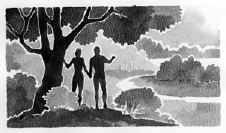 |
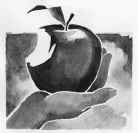 |
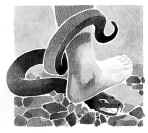 |
God gave Adam and Eve permission to eat fruit from the many different trees in the garden, including the fruit of the “tree of life” (Genesis 2:9, 16). That tree symbolized constant access to God and eternal life (Revelation 2:7; 22:14). Only one tree was off limits. God told Adam and Eve, “You must not eat from the tree of the knowledge of good and evil, for when you eat of it you will surely die” (Genesis 2:17). Adam and Eve were faced with a test of obedience. Would they listen to their Creator’s instructions, or would they choose to disobey?
The wily serpent, who symbolized Satan the devil (Revelation 12:9), now entered the scene. He approached Eve, and, imputing an evil intention to God’s command, expressed his own doubts (Genesis 3:1). The serpent’s objective was to pose as a benefactor, to entice Adam and Eve to sin. The serpent said to Eve: “You will not surely die…. For God knows that when you eat of it your eyes will be opened, and you will be like God, knowing good and evil” (verses 4-5).
Eve was enticed by Satan’s words. She had to see for herself if she would truly receive this Godlike power. Eventually, Eve “took some and ate it. She also gave some to her husband, who was with her, and he ate it” (verse 6). The first man and woman failed their basic test of faith. Thousands of years later, the apostle Paul explained that both Adam and Eve were guilty of sin in this action (Romans 5:12-14; 2 Corinthians 11:3).
The serpent had cleverly undermined the relationship that should have existed between human beings and God. He tricked our first parents into defying the Creator’s command by suggesting that God was greedy and selfish and was trying to keep something good away from them. Through an attitude that was an affront to God himself (Psalm 51:4), Adam and Eve ruined their chances of living a God-centered life. The serpent had lured them into alienating themselves from their Creator.
By disregarding God’s command, Adam and Eve had made a fateful choice. They had attempted to run their lives according to what seemed right to them and not according to the principles clearly enunciated by God. They usurped God’s authority and set themselves up as lawgiver, judge and jury of the way things ought to be. The couple asserted their independence from God, and grasped at an imagined equality with him. They thought that the forbidden fruit would be the key to vital knowledge they needed – knowledge that God was withholding from them.
Adam and Eve liked the idea of being “like God” in knowledge. But their perception was terribly distorted. God’s intention was for them to grow in knowledge through seeking his divine will and unlimited wisdom. Through their disobedience, the first humans terminated their contact with the only sure source of truth. In this sense, they barred themselves from the Garden of Eden and from the tree of life (Genesis 3:24).
Yet, even as Adam and Eve cut themselves off from God’s presence, he mercifully gave them a promise and a hope for the future salvation of the human race. In what is often called the Bible’s first messianic prophecy, God told the serpent, “I will put enmity between you [Satan] and the woman, and between your offspring and hers; he [the Savior] will crush your head, and you will strike his heel” (verse 15).
To reverse the consequences of human sin, God would send his Son, Jesus Christ, to die for us. Satan would strike the heel of the Savior, Jesus Christ, through the crucifixion. However, Jesus would triumph over evil and death through his resurrection from the dead. Thus, he was prophesied from the beginning to “crush” Satan’s head by destroying the power of sin and the serpent’s sin-filled system.
The disobedience of our parents, Adam and Eve, plunged the human race into sin (Romans 5:12). Yet, when we uncover the complete biblical picture, we see that, in spite of our flawed past and uncertain present, we humans can look forward to a positive future.
God has a plan to save humanity, and the Bible tells us about that plan. It is, above all, a story of hope! As we explore the Word of God, we will discover that we are destined to inherit eternal life in the kingdom of God. To experience this magnificent purpose, however, we must first be reconciled to God through the sacrifice of his Son, Jesus Christ (Romans 5:9-21).
The first murder: chapter 4
 |
| “And while they were in the field, Cain attacked his brother Abel and killed him” (Genesis 4:8). This detail of Cain killing Abel is from Ghiberti’s The Gate of Paradise, Florence, Italy. |
Adam and Eve had two sons: Cain and Abel. Each brought an offering to God. God rejected Cain’s offering but found Abel’s sacrificial offering pleasing because it was given in faith (Hebrews 11:4). It typified Christ’s work on our behalf. Cain became bitter and resentful. He ignored God’s advice (Genesis 4:7) and murdered his brother Abel. God then condemned Cain to a life of wandering and alienation (verse 12).
Verses 17-24 list some of Cain’s descendants, and show the organized beginnings of civilized life. But the sinful nature of humans continued to haunt them. Lamech, for example, boasted of a murder he had committed.
From Adam to Noah: chapter 5
Family trees (genealogies) similar to this one are often given in the Bible. They describe a line of descent. Some of these genealogies are selective. For example, names are sometimes left out to underscore a spiritual lesson. Therefore, it is not always possible to compute chronology and exact historical dates simply by adding up all the numbers.
It is interesting to compare Genesis 5:1 with Matthew 1:1. In Genesis, we have “the book of the generations of Adam” (KJV), a record of the descendants of the first Adam, most of whom rejected God. “The book of the generation of Jesus Christ” (KJV), on the other hand, introduces the Gospel record of the “second Adam,” Jesus Christ the redeemer. “For as in Adam all die, so in Christ all will be made alive” (1 Corinthians 15:22).
In this context, Adam and Christ are pictured as heads of two contrasting governments. To whom will you give allegiance? Will you follow Adam in death, or will you accept Jesus as Lord and live?
The great flood: chapters 6–9
The human race became increasingly violent and corrupt over the next few centuries, which led to God’s intervention with a flood. God told his servant Noah to build an ark in which Noah and his family, and animal and bird life would be protected from this great flood. The Bible describes Noah as a saint among sinners, the only light in his crooked and perverse generation. In a world of sin, he alone was faithful to God (Genesis 6:8-9).
The ancient story of Noah building his ark is much more than history. God instructed Noah to build the ark because a crisis was at hand. But the people of Noah’s day saw no such crisis. For them, life would continue with business as usual.
This is the normal attitude of the majority. “In the days before the flood,” said Jesus,” people were eating and drinking, marrying and giving in marriage…until the flood came and took them all away” (Matthew 24:38-39).
Even when Jesus preached and healed the sick, many failed to recognize the miraculous nature of what was happening in their time. “You know how to interpret the appearance of the sky,” Jesus told his generation, “but you cannot interpret the signs of the times” (Matthew 16:3).
Noah’s neighbors looked at the ordinary skies, which seemed to promise ordinary weather. They did not perceive the troubled and turbulent moral climate – a sign of imminent disaster. But Noah, because he was a just man and walked with God, was enabled to see what others could not.
How about you? Do you assume that only the visible is real?
God’s covenant with Noah: chapters 6:18; 8:20–9:17
Covenants are an important and recurring theme in the Bible. God established special covenants (agreements) with Noah, Abraham, Moses and David. For example, when Noah stepped out of the ark onto an earth devoid of human life, God gave him a reassuring promise, in three parts, shown below.
The series of biblical covenants culminates in the coming of Jesus Christ and the ushering in of a new and better covenant (Jeremiah 31:31; Hebrews 7:22, 8:6).
The Rainbow Covenant |
|
Genealogies provide valuable historical links. Chapter 10 gives the genealogy of Noah’s three sons: Shem, Ham and Japheth. Shem’s family appears last since the next major episode of the story develops around his descendants. But first, the story of Babel.The Tower of Babel: chapter 11:1-9
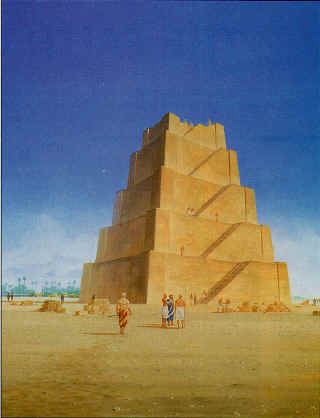 |
| Based on archaeological evidence, an artist’s impressionshows how the Tower of Babel may have looked, with stairways leading up from one level to the next. |
After the flood, the human race lived in the same geographic area and spoke one language (verse 1). During their wanderings eastward, the descendants of Noah came across a plain in Mesopotamia where they decided to settle. Their ambition was to build “a city, with a tower that reaches to the heavens, so that we can make a name for ourselves” (verse 4).
Displeased by their arrogance, independence and lack of trust in their Creator, God intervened, confused their language and scattered them over all the earth (verse 8). He did this for their own good; what is contrary to God’s will is never in humanity’s best interest. The people abandoned their ungodly project, leaving the city and tower unfinished.
The city is normally identified with Babylon. Babel is a Hebrew word meaning “gate of god,” which is linked with balal, meaning “to confuse” (verse 9). The story illustrates the futility of humanity’s attempt to challenge God’s supremacy.
From Shem to Abram: chapter 11:10–32
Once again we find a selective list of names. With Terah (verse 27), the list becomes more detailed. After the death of his father, Nahor, “Terah took his son Abram, his grandson Lot…and his daughter-in-law, Sarai…to go to Canaan” (verse 31). The stage is now set for the story of Abram, whom God later renamed Abraham. (Abram’s new name signified God’s promise to make him the “father of many nations” – see Genesis 17:5.)

